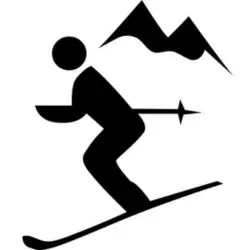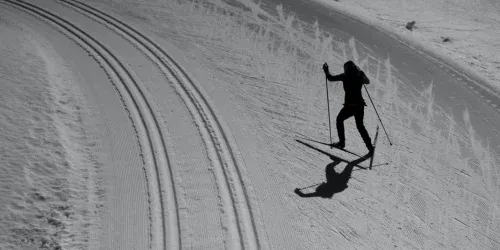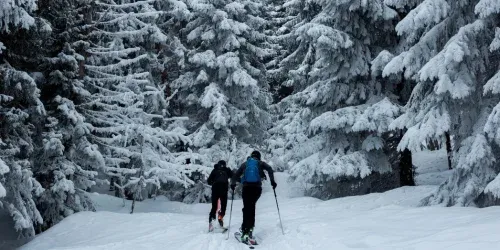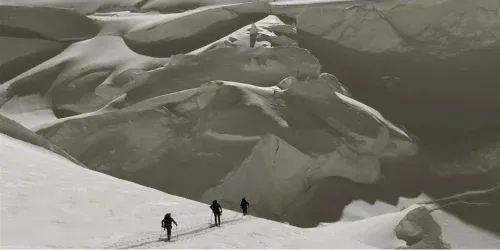Cross country skiing is an incredible winter sport that combines both a full-body workout and the serene experience of moving through snowy landscapes. However, to get the most out of your skiing experience, it's crucial to have the right equipment, and that includes properly sized ski poles. This comprehensive guide will walk you through how to size cross country ski poles, ensuring you have the correct length for your skiing style and body height.
Key Takeaways:
- Understanding the difference between classic and skate ski poles is essential for proper sizing.
- Body height and ski technique are key factors in determining the right pole length.
- Personal preference plays a role in the final decision, but following a size chart can provide a good starting point.

The Basics of Ski Pole Sizing
When you're standing upright, the right ski pole length will allow you to hold the grips with your elbows at a 90-degree angle. This is a general rule of thumb for classic skiing, where pole length is critical for maintaining balance and rhythm. For skate skiing, poles are typically longer to accommodate the different technique used.
Classic Poles vs. Skate Poles
Classic poles and skate poles differ in length. Classic poles should reach up to your armpit or shoulder height, while skate poles are longer, often coming up to the chin or lower lip. This difference is due to the varied techniques used in each style of cross country skiing. Skate skiers use longer poles for greater leverage and push-off, while classic skiing requires slightly shorter poles for stability and double poling.

Measuring Your Body Height
To determine the right pole size, start by measuring your body height. Stand against a wall with your ski boots on to get an accurate measurement from the floor to the top of your head. This measurement will serve as a base for calculating the correct pole length using a size chart or formula.
Using a Size Chart
Most ski stores and manufacturers provide a size chart that correlates your height to the recommended pole length. These charts are a great starting point, but remember that they are not one-size-fits-all. Factors like personal preference and ski technique might lead you to choose a pole that's slightly different from the chart's suggestion.

Factoring in Ski Technique
Your ski technique can influence the ideal pole length. For instance, if you're an aggressive skater, you might prefer longer poles to maximize your push. Conversely, if you're new to skate skiing, slightly shorter poles might help you maintain control as you learn.
The Importance of Pole Material
The material of your ski poles can affect your skiing experience. Lightweight materials like carbon fiber are preferred for their strength and ability to reduce fatigue. However, they can be more expensive. Aluminum poles are a more affordable option but are heavier and might not perform as well in terms of flexibility and swing weight.
Adjusting for Personal Preference
Personal preference should not be overlooked when sizing your ski poles. Some skiers prefer poles that are slightly longer or shorter than the standard recommendation. It's important to try different lengths to see what feels most comfortable and effective for your skiing style.
Checking the Pole Tip and Basket
The pole tip and basket are essential components that should be considered when sizing your ski poles. The tip needs to be sharp and durable to grip the snow, while the basket prevents the pole from sinking too deeply into soft snow. Make sure these parts are in good condition and suitable for the terrain you'll be skiing on.

Trying Before Buying
If possible, test different pole lengths before making a purchase. Visit a local ski shop where you can try out poles and even test them on snow. This hands-on approach will help you feel the difference in pole lengths and make an informed decision.
When to Replace Your Ski Poles
Ski poles can break or wear out over time. Inspect your poles regularly for signs of damage, such as cracks in the material or a loose strap. If your poles are damaged or no longer suit your skiing style, it's time to size and purchase new ones.

Summary
Sizing cross country ski poles correctly is vital for an enjoyable and effective skiing experience. Whether you prefer classic or skate skiing, the right pole length is determined by your body height, ski technique, and personal preference. Use a size chart as a guideline, but don't hesitate to adjust based on what feels right for you. Remember to consider the material, pole tip, and basket, and always try before you buy.

FAQs
How do I know if my ski poles are the right length for classic skiing?
For classic skiing, your poles should reach up to your armpit or shoulder height when you're standing upright with the pole tip touching the ground. Your arms should be at a 90-degree angle when holding the grips.
Can I use the same poles for classic and skate skiing?
It's not recommended, as skate poles are typically longer to accommodate the skating technique. Using poles that are too short or too long can hinder your performance and enjoyment of the sport.
How often should I replace my cross country ski poles?
Replace your ski poles if they show signs of significant wear, such as cracks or a loose strap. Even without visible damage, consider replacing them if they no longer suit your skiing style or if you've had significant changes in technique or body height.
Can you use trekking poles for cross country skiing?
While trekking poles can technically be used for cross country skiing, they may not provide the best experience due to their design differences.









